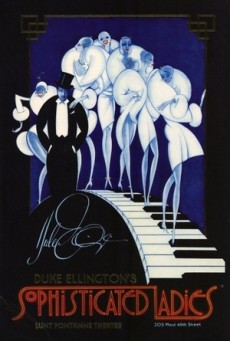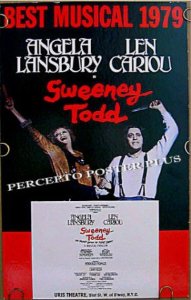
From Broadway To 52nd Street
Ridin’ High is a 1936 popular song, composed and written by Cole Porter, for the stage in his musical Red, Hot and Blue, with book by Howard Lindsay and Russel Crouse. It premiered on Broadway in 1936 and the song was introduced by Ethel Merman.
The musical also introduced the popular song It’s De-Lovely as a romance duet sung by Ethel Merman and Bob Hope, in which they trace their romance from first kiss to marriage to a baby.
The StoryNails O’Reilly Duquesne is a newly wealthy young widow. Loud and brassy, Nails is a former manicurist. She organizes a benefit for her favorite cause, the rehabilitation of ex-convicts. Together with her sidekick (an “ex-con” himself), Policy Pinkle, and her “square” boyfriend, lawyer Bob Hale, she embarks on a nationwide search for Bob’s old girlfriend, which is really the reason for the enterprise. The girlfriend, 18 years earlier, had sat upon a hot waffle iron and so had a unique “imprint”. However, the national lottery that Nails starts gets the attention of the Finance Committee, and they wind up in Washington DC in an even more complicated situation. The Supreme Court declares the lottery unconstitutional, because it would benefit the people.
History
During the out-of-town tryouts, the book was too long and did not blend with the music. The producer Vinton Freedley made numerous suggestions for overhauling the show, which were accepted by all except Porter, until he finally relented. Additional conflicts arose when Freedley assembled the cast and creative team behind the musical Anything Goes, hoping to repeat that show’s success. William Gaxton was part of that cast, however, he withdrew because Ethel Merman’s part was so large, so Bob Hope was cast. The next conflict came over billing for Jimmy Durante and Merman, which was resolved by having their names crisscrossed above the title.
The musical was first titled But Millions!, then Wait for Baby!, before settling on Red, Hot And Blue. The Broadway musical has no connection to the 1949 film musical of the same name with songs by Frank Loesser.
Notable RecordingsBenny Goodman, Chris Connor, Ella Fitzgerald, Michel Legrand, Kate Smith, Mark Murphy, Jeri Southern, Peggy Lee, Teresa Brewer, Carol Lawrence, Doris Day, Johnny Mathis, Cleo Laine, Sue Raney, Hod O’Brien, Robert Palmer, Rebecca Martin, Fay Claassen, and Stevie Holland.

From Broadway To 52nd Street
As our final installment on the musicals and the songs that have gone on to become classics in the jazz catalogue, Broadway has entertained millions of audiences from around the world and has touched every human emotion and story one can imagine. It has captured our hearts and taken us on journeys to unexpected destinations both visceral and intuitive.
The Broadway musical played an integral role in the creation of the Great American Songbook as songs from the legendary composers and lyricists like Gershwin, Porter, KernRodgers, Hammerstein, Van Heusen, Hart, Webber, Rice, Loesser, Bricusse, Newley, Styne, Comden etc. have filled the pages of our imaginations
The “blockbuster” musicals were so successful that they ran over a thousand performances. A small aggregation of only 17 comprised of Oklahoma (2,212), Annie Get Your Gun (1,147), Kiss Me Kate (1,077), South Pacific (1,925), Guys & Dolls (1,200), The King And I (1,246), The Pajama Game (1,063), My Fair Lady (2,717), How To Succeed In Business (1,417), Funny Girl (1,348), Hello Dolly (2,844), Fiddler On The Roof (3,242), The Sound Of Music (1,443), Mame (1,508), Promises, Promises (1,281), Ain’t Misbehavin’ (1,604) and Evita (1,567).
To describe Broadway one would beg permission to borrow from Tevya in Fiddler On The Roof – “without tradition our lives would be as shaky as a fiddler on the roof!”
The lyrics and composition that were relegated to the amphitheaters of “The Great White Way” have received perpetual encores over the past century under the auspices of “The Street” and the songs continue to be honored by living legends, contemporaries and the “new breed” of jazz musicians and vocalists.
52nd Street, between Fifth and Seventh Avenues was known as “Swing Street” was equally attended by hundreds of thousands during its heyday between the 1930s and 1950s in just thirteen clubs. Equally blockbuster are the million selling albums of Miles Davis (Kind of Blue), Dave Brubeck (Time Out), John Coltrane (A Love Supreme, Blue Train), Herbie Hancock (Headhunters), Louis Armstrong (What A Wonderful World), Ella Fitzgerald (Best of the Songbooks).
To describe 52nd Street one would merely state that it was the epicenter of jazz in New York City and the connection between the musicians who played on Broadway and the legitimate clubs. It was the place where musicians who played for others earlier in the night, played for themselves on 52nd Street.

From Broadway To 52nd Street
Sophisticated Ladies had a preview run of 15 shows beginning February 16th prior to its official opening at the Lunt Fontanne Theatre on March 1, 1981 and ran for 767 performances. Duke Ellington composed the music for the revue with a cast that included Gregory Hines, Judith Jamison, Phyllis Hyman, Hinton Battle, Gregg Burge and Mercer Ellington. Hines’ older brother Maurice joined the cast later in the run.
The score includes classic jazz tunes “Mood Indigo,” “Take The “A” Train, I’m Beginning To See The Light, Hit Me With A Hot Note and See Me Bounce, It Don’t Mean A Thing (If It Ain’t Got That Swing), I Let A Song Go Out Of My Heart, Old Man Blues, In A Sentimental Mood, Sophisticated Lady, Don’t Get Around Much Anymore, Satin Doll and I Got It Bad And That Ain’t Good among numerous others.
Jazz History: In the 1980s the jazz community shrank dramatically and split. A mainly older audience retained an interest in traditional and straight-ahead jazz styles. Wynton Marsalis strove to create music within what he believed was the tradition, creating extensions of small and large forms initially pioneered by such artists as Louis Armstrong and Duke Ellington. In the early part of the decade, a commercial form of jazz fusion called pop fusion or smooth jazz became successful and garnered significant radio airplay.
Smooth jazz received frequent airplay with more straight-ahead jazz in “Quiet Storm” time slots (a format begun at Howard University’s WHUR by host Melvin Lindsay) at radio stations in urban markets across the United States. This helped to establish or bolster the careers of Grover Washington, Jr., Kenny G, Kirk Whalum, Boney James and David Sanborn and vocalists including Al Jarreau, Anita Baker, Chaka Khan and Sade.
In this same time period “Echoes of an Era” was released by the sextet comprised of Chaka Khan (vocal), Joe Henderson (saxophone), Freddie Hubbard (trumpet), Chick Corea (piano), Stanley Clarke (bass) and Lenny White (drums). The quintet released another “Echoes” enlisting the vocal talents of Nancy Wilson. The quintet would also release two albums titled “The Griffith Park Collection”.
Sponsored By
www.whatissuitetabu.com

From Broadway To 52nd Street…
Evita opened at the Broadway Theatre on September 25, 1979 and ran 1,567 performances. The musical starred Patti Lupone, Mandy Patinkin, Bob Gunton, Mark Syers, Jane Ohringer singing music composed by Andrew Lloyd Webber with lyrics by Tim Rice. The show began as a rock opera concept album released in 1976. Its success led to productions in London’s West End in 1978, and on Broadway a year later, both of which enjoyed considerable success. A major 1996 film of the musical was made, starring Madonna and Antonio Banderas. The musical was revived in London in 2006. Evita has had numerous professional tours and worldwide productions, and numerous cast albums have been recorded, and won a 1980 Grammy. “Don’t Cry For Me Argentina” has become an entry into the catalogue of jazz standards.
The Story: Evita is a musical that concentrates on the life of Argentine political leader Eva Peron, the second wife of Argentinian President Juan Peron. The story follows Evita’s early life, rise to power, charity work, and eventual death.
Broadway History: The Booth Theatre was given its name in recognition of one of the great contributors to American theatre. However, the current Booth Theatre does not get its name from an accomplished actor, playwright, or producer. It comes instead from the original Booth Theatre, which was originally located on 23rd Street and 6th Avenue. The original Booth Theatre, which opened on February 3, 1869 with a production of Romeo and Juliet, derived its name from Edwin Booth, an accomplished Shakespearean actor, who unfortunately happens to be the brother of infamous actor/assassin John Wilkes Booth. Although demolished only fourteen years later in 1883, the theatre revolutionized American drama by incorporating hydraulic ramps to change scenery, an electric device that allowed changes in lighting, and a sprinkler system. Fun fact, the top floor of the original theatre’s adjoining shop and rehearsal space was reserved as Edwin’s personal apartment.
Sponsored By
www.whatissuitetabu.com

From Broadway To 52nd Street
Sweeney Todd opened at the Uris Theatre on March 1, 1979 and ran for 557 performances. The musical starred Angela Landsbury and Len Cariou with music composed by Stephen Sondheim from which came the song Pretty Women that entered into the jazz pantheon. The show would also win Best Musical for that year.
The Story: The Demon Barber of Fleet Street was set in the 19th century London. Todd is a barber who dispatches his victims by pulling a lever as they sit in his barber chair. Todd “polishes them off”, slitting their throats with his straight razor before dispatching them into the basement via the revolving trapdoor. After Todd has robbed his dead victims of their goods, Mrs. Lovett, his partner in crime assists him in disposing of the bodies by baking their flesh into meat pies and selling them to the unsuspecting customers of her pie shop. Todd’s barbershop is situated at 186 Fleet Street and is connected to Mrs. Lovett’s pie shop by means of an underground passage.
Jazz History: The end of the 70s decade saw trumpet virtuoso Wynton Marsalis in New York and a hard bop revival was soon underway. Bassist and composer Charles Mingus dies in Mexico at the age of 56. Vocalese singer Eddie Jefferson dies on May 9 in Detroit, Michigan. A jam session at the Brecker brothers’ club will produce the group Steps Ahead. Gil Scott Heron is experimenting with a new form of music which involves spoken poetry set to music, similar to what will later be known as hip hop and rap; the first Sony Walkman (model TPS-L2) hits the market and two years later the word “Walkman” enters the dictionary, and the product changes listening habits forever.
Sponsored By
www.whatissuitetabu.com




